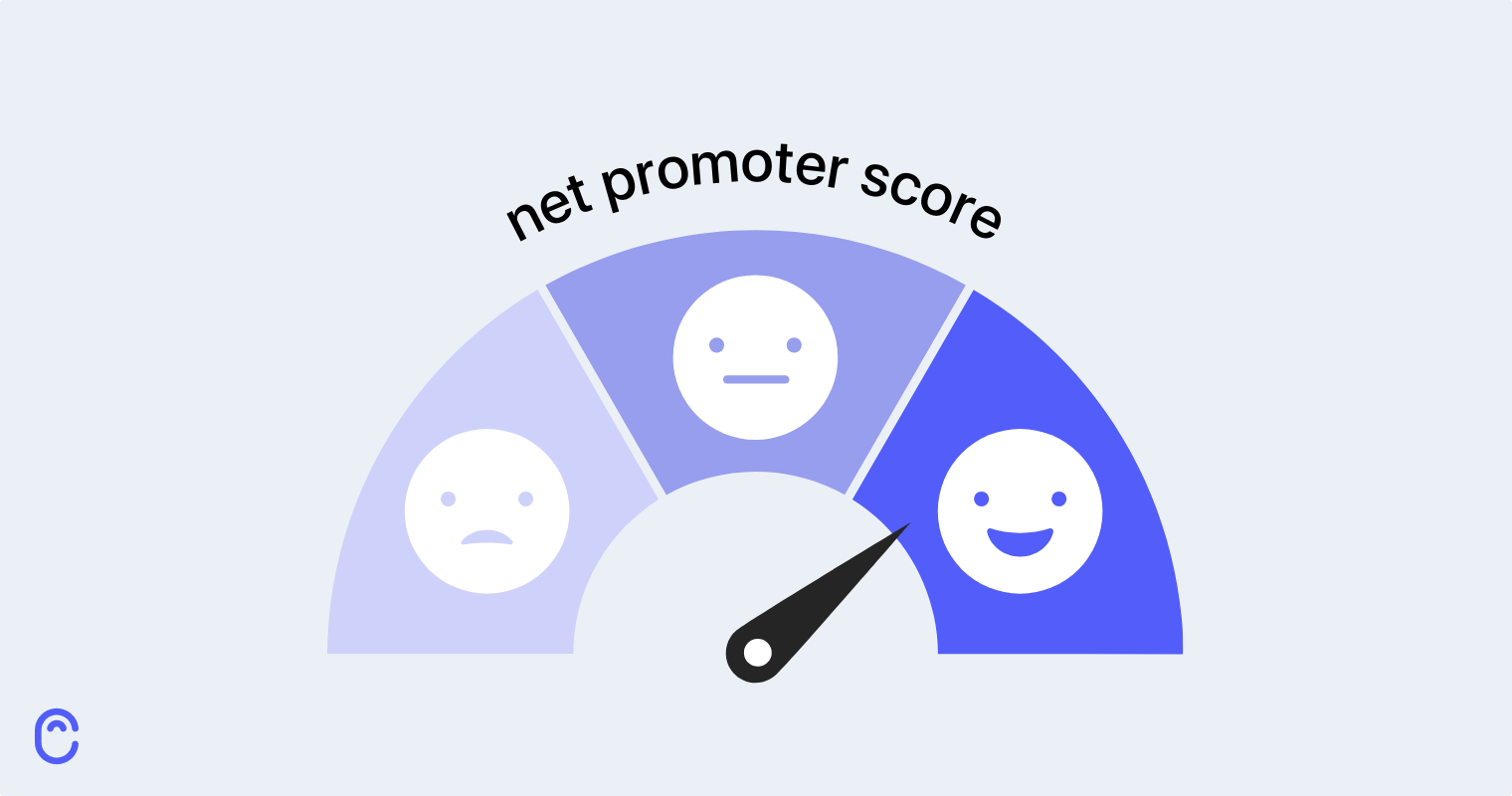Look at any popular brand, and you’ll notice one thing: happy customers who tell others about it. For example, people who use iPhones or Teslas love to share how much they like them.
This kind of word-of-mouth marketing helps brands grow. When customers recommend a brand, it builds trust that ads can’t.
One way to see how well a brand is doing is with something called the Net Promoter Score (NPS). NPS shows how likely customers are to tell others about the brand. A high score means customers are happy and likely to bring in new people.
Building loyalty takes work. It means understanding what customers
It means understanding what your customers want and making sure they’re happy. When you do this, customers naturally spread the word.
In this post, we’ll go over ways to raise your NPS. When it goes up, you get more loyal customers who help your business grow.
Understanding NPS
NPS shows how loyal your customers are via a simple question. You ask your customers, “On a scale of 0-10, how likely are you to recommend our company to your friends or colleagues?”
Depending on their answers, customers fall into three groups:
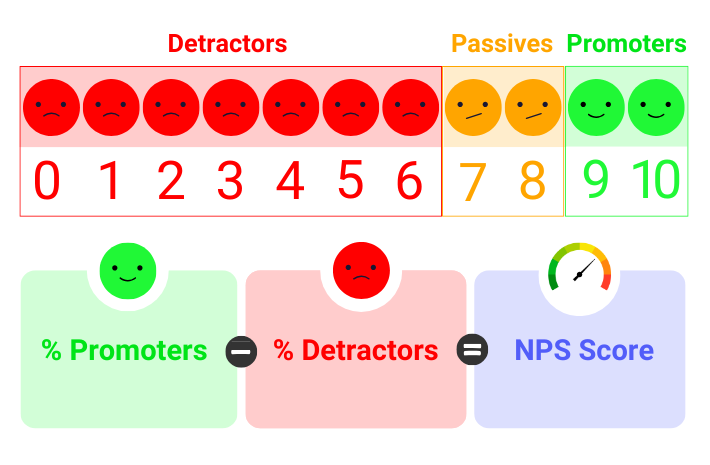
- Promoters (9-10): These are your biggest fans who help your company grow.
- Passives (7-8): These customers are happy, but they might choose another brand.
- Detractors (0-6): These customers are not happy and could hurt your brand.
To find the NPS, use this formula:
NPS = % of Promoters (9-10) – % of Detractors (0-6)
A low NPS means customers are upset and might leave. A high NPS means you have loyal customers who help your business grow.
For example, Tesla has a great score of 97 because they keep their quality high, come up with new ideas, and provide good service. Starbucks has a score of 77, and USAA has 75. Both give good value to their customers.
Different industries have different scores, but any score above 70 is considered great.
7 actionable tips to improve your NPS
Reaching an NPS score of 70 or higher takes strategy. Here are simple tips to help you get there:
1. Act on feedback quickly
Fast responses matter. When a customer shares feedback, it’s your chance to build trust. The quicker you respond, the better.
Set up instant notifications for feedback
Connect your feedback system to tools like Slack or email. This way, feedback goes to the right person immediately. In turn, your team can respond faster.
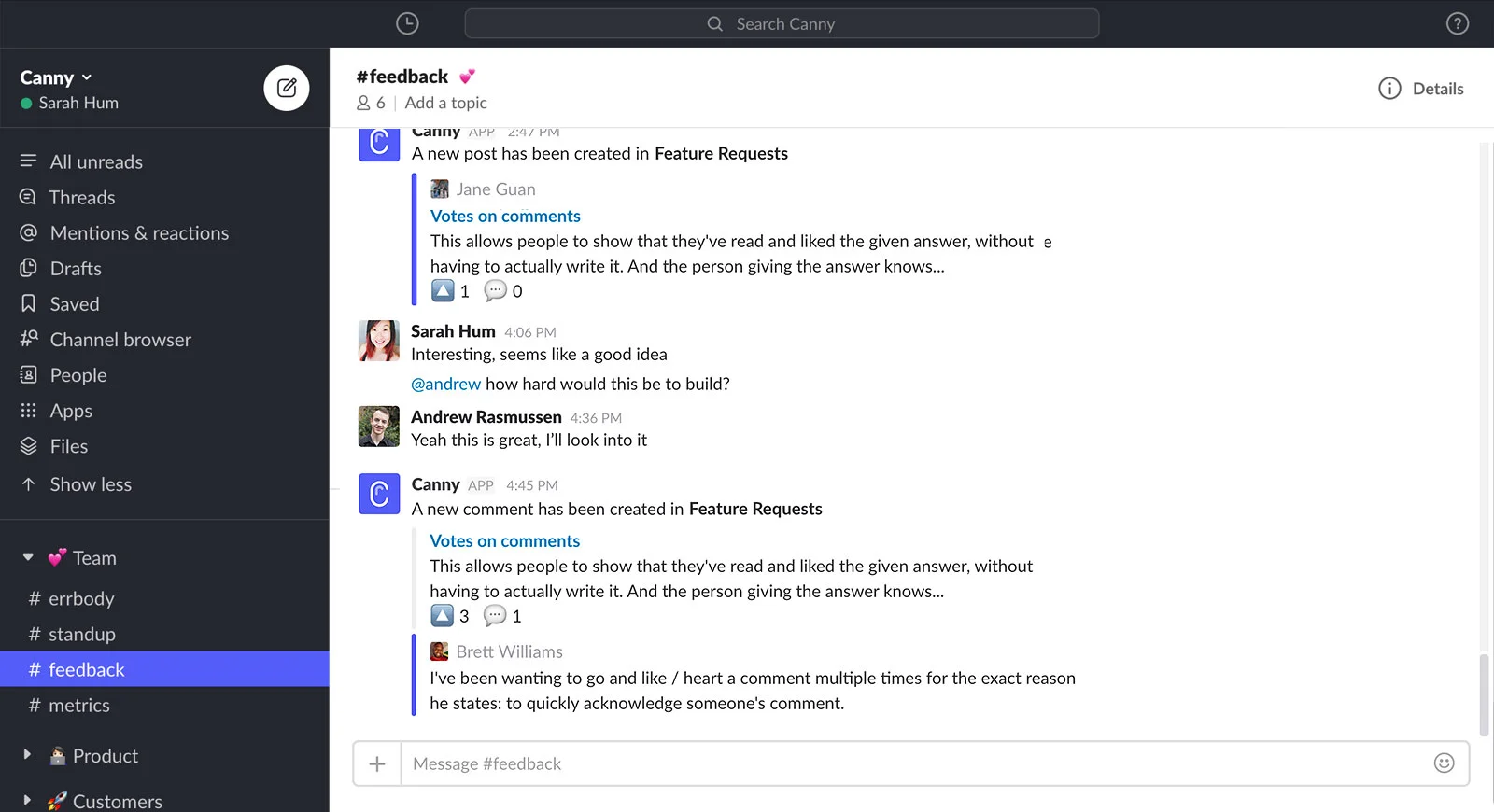
For example, connect your feedback portal to Slack or email. This way, feedback goes to the right person right away. Nothing gets missed, and your team can respond quickly.
Use response templates for common issues
Look for patterns in your feedback and use templates. For happy customers, send a thank-you and ask for a referral. For neutral feedback, ask how you can improve. For unhappy customers, use templates that show you’re listening and care.
For all these types of feedback, here’s a format that works:
- Opening: Personal acknowledgment of their specific issue
- Middle: Clear the next steps you’re taking
- Close: Timeline for resolution and your direct contact info
Here’s a template that you can customize for managing detractor feedback well:
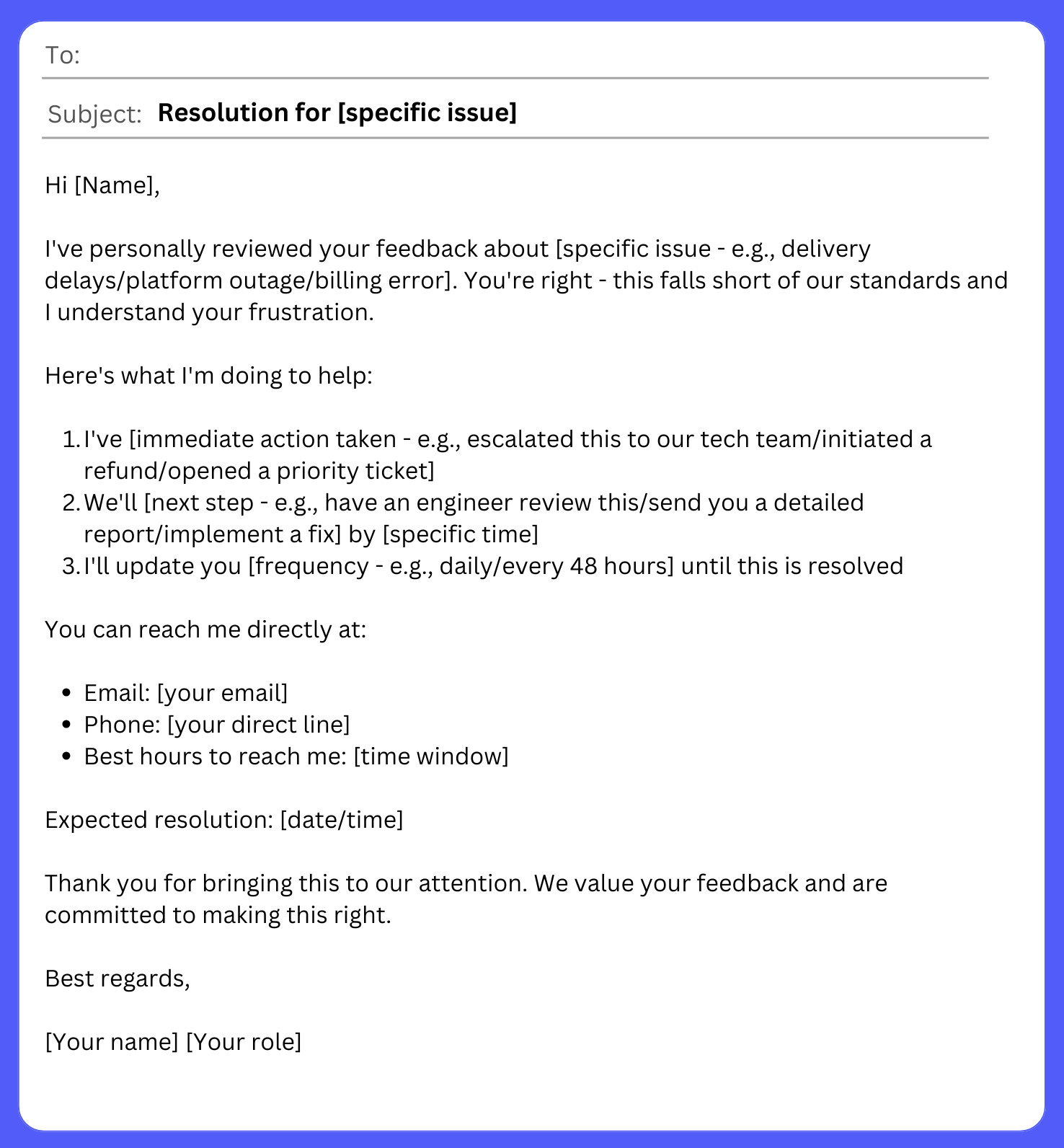
Choose the right team to handle negative feedback
Your team needs to act fast on negative feedback to keep customers happy and build customer loyalty. Pick experienced team members to handle these issues. Set up a schedule so someone’s always available.
Give them tools to respond quickly, like:
- The ability to give refunds right away
- A direct line to the tech team for urgent fixes
- Options to upgrade accounts or extend subscriptions
- A “customer help” budget for emergencies
Train them in problem-solving and calming down upset customers. The goal isn’t just fixing issues—it’s turning unhappy customers into loyal fans.
Track response times and set aggressive goals
Fast replies make a big difference in customer service. Think about it—waiting even a day feels like forever when you reach out to a company.
So, set goals for response times; it shows customers you value their time. Try this simple rule: respond to urgent issues in 1 hour. Quick action helps calm frustrated customers.
You can take regular feedback in 4 hours, and feature requests within 24 hours. Your help desk software can track this automatically.
Keep your eye on these key metrics:
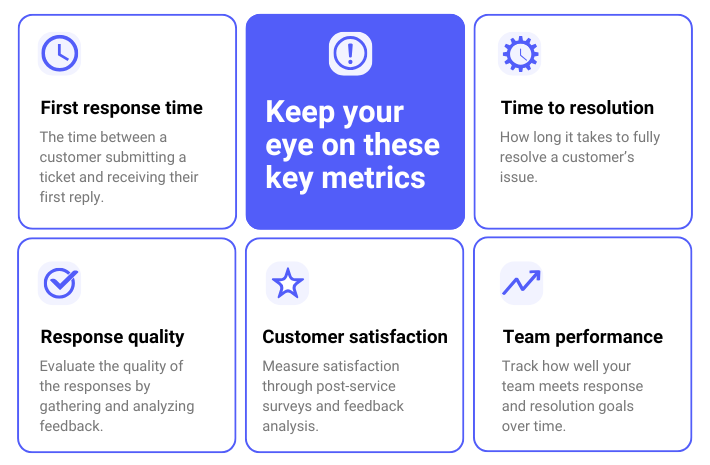
Watch key patterns too. When do customers give the most feedback? Which products are mentioned most? Where are there delays? These insights help you put your team right where they’re needed most.
2. Create a customer success roadmap
If your customers have a smooth journey with your brand, they’ll be more likely to tell their friends. Every time they connect with you or ask for help, it affects how they feel about your brand.
To improve your NPS, map out these key points:
- First-time user experience
- Onboarding process
- Regular usage milestones
- Support interactions
- Renewal or repurchase moments
Start by looking at each step from the customer’s view. Note every click, call, or step they take. Where do they get stuck? When do they need help? These are chances to make things better.
Turn rough spots into “wow” moments. For example, if customers have trouble at checkout, surprise them with free shipping or a discount at the final step. Or, like Grammarly, you could give users helpful tools for using your product more easily.
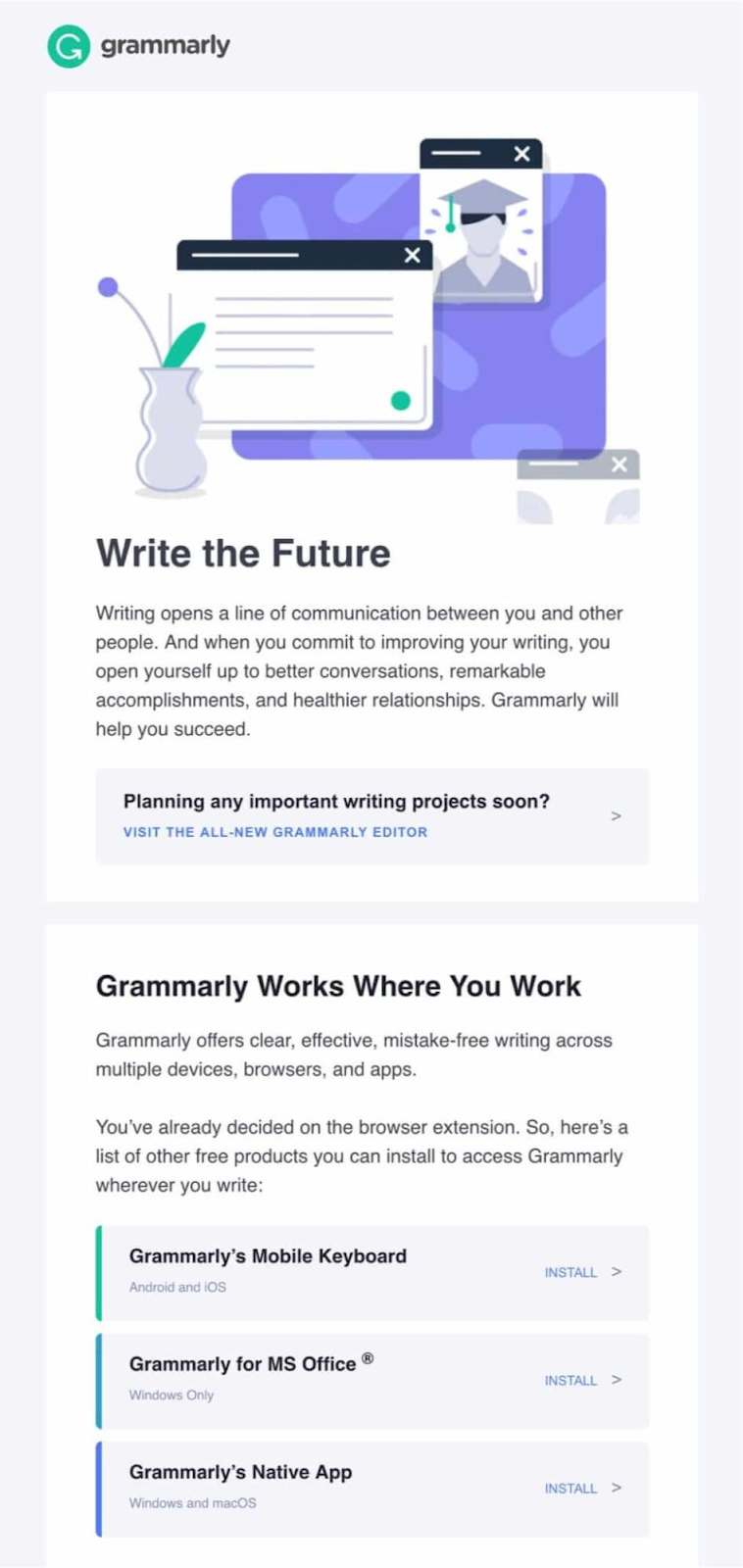
[Source]
The goal is to create moments so great that customers want to share them. People don’t share average experiences, but they will tell others about brands that make them feel special.
3. Empower your support team
Your support team is key to keeping customers happy. They can turn customers into loyal fans if they have the right tools and authority.
Give your team the power to:
- Make quick decisions without asking a manager
- Offer refunds when needed
- Adjust rules in special cases
Support works best with the right tools. Use a good CRM so they can see customer history easily. Build a knowledge base with answers to common problems to help them solve issues fast.
4. Transform feedback into features
Your customers are telling you what they want—you just need to listen. When a lot of people mention the same problem or request, it’s a great chance to make things better. Here’s how to use their feedback:
Set up a feedback system: Gather all feedback in one place. Use a feedback tool like Canny to sort feedback by type, like new features, problems, or ideas. This helps you see what’s most important.
Build what customers want: Focus on the features that customers ask for the most. Talk to them to find out what would improve their experience. Then, choose changes that make a big difference and are easy to make.
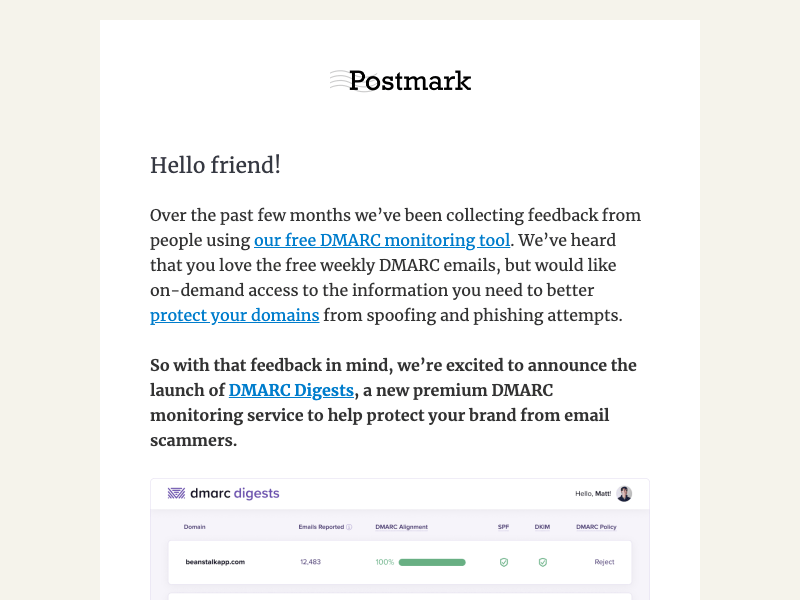
[Source]
- Update your customers: When you make a change that someone asked for, let them know. This shows you care and can turn customers into loyal fans.
5. Personalize the experience
Nobody wants to feel like just another ticket number. In an age where Netflix knows what you want to watch next, your customers expect personalization. The good news? Even small personal touches can make a big impact.
Personalization opportunities:
- Remember preferences: Note customer preferences to show them more of what they like.
- Customize recommendations: Send timely refill reminders or product updates for past purchases.
- Send relevant content and updates: Send content based on browsing history or purchases.
6. Create educational content
When your customers truly understand your product, they become your biggest advocates. The more value they get, the more confident they’ll feel recommending it to others.
So, make sure educational content is easy to find so customers can learn more about your product.
What your content toolkit should include:
- Quick-start guides: Create visual guides that help them hit their first goal quickly. Focus on the key actions that deliver immediate value.
- Video tutorials: Some things are easier to show than explain. Create short, targeted videos (under 3 minutes) that explain specific features or tasks. Include captions to make them accessible to everyone.
- Best practice documents: Share insider tips and explain the “why” behind best practices. It’ll help users know what to do and understand how it benefits them.
Pro Tip: Don’t wait for users to stumble across your content. Engage your customers proactively and share relevant resources at the right time, based on where they are in their journey.
7. Celebrate customer wins
Success spreads! When you share a customer win, it inspires others and shows what can happen. Happy customers often become your biggest fans. Here’s how to celebrate these wins:
Create stories: Turn customer successes into fun stories or detailed case studies. Share how they faced challenges and what great results they got. Make sure the stories are real so others can learn from them.
Spotlight customers: Highlight your successful customers in your blog or newsletter. Let them share their advice and tips. This shows they are leaders and celebrates them.
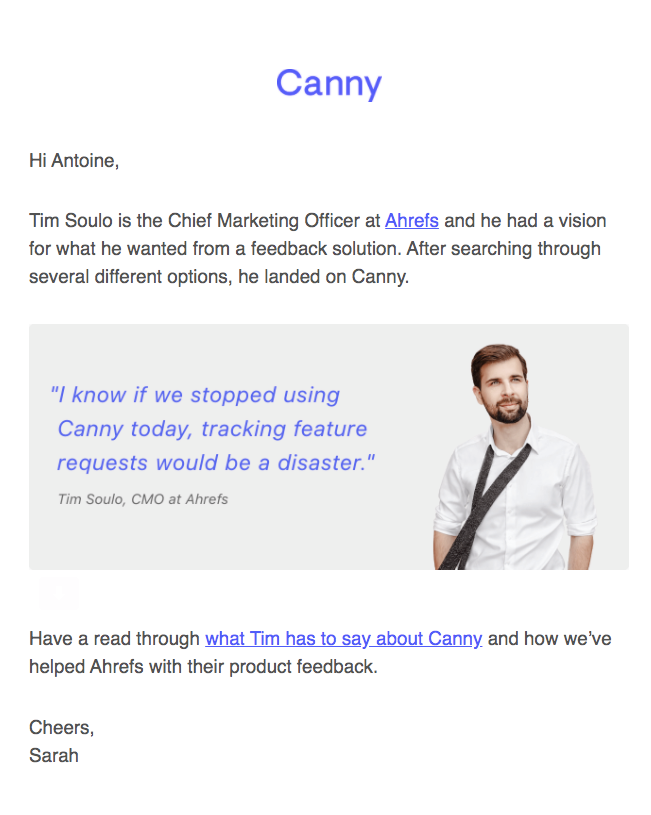
Share on social media: Post updates and special moments on social media. Use fun pictures to show customer achievements and happy quotes. Make it easy for them to share with friends.
Build a community: Create a space where customers can share their wins. Encourage them to celebrate each other and give advice. This helps everyone feel connected.
Focus on real achievements. Celebrating customer success leads to even more success!
At DesignRush, we give awards to great designs in websites, logos, apps, and multimedia. We showcase their work and stories on our site to give them more visibility. This often helps them find new opportunities and partnerships.
5 tools to help you improve your NPS
If you want to make your customers happy, you need to listen to what they say. These five tools can help you gather and use their feedback easily.
1. Canny Autopilot
Canny Autopilot helps you collect and understand what customers want. It keeps their requests organized and finds the most popular ideas quickly. This tool is perfect for teams that want to make their products better based on customer feedback.
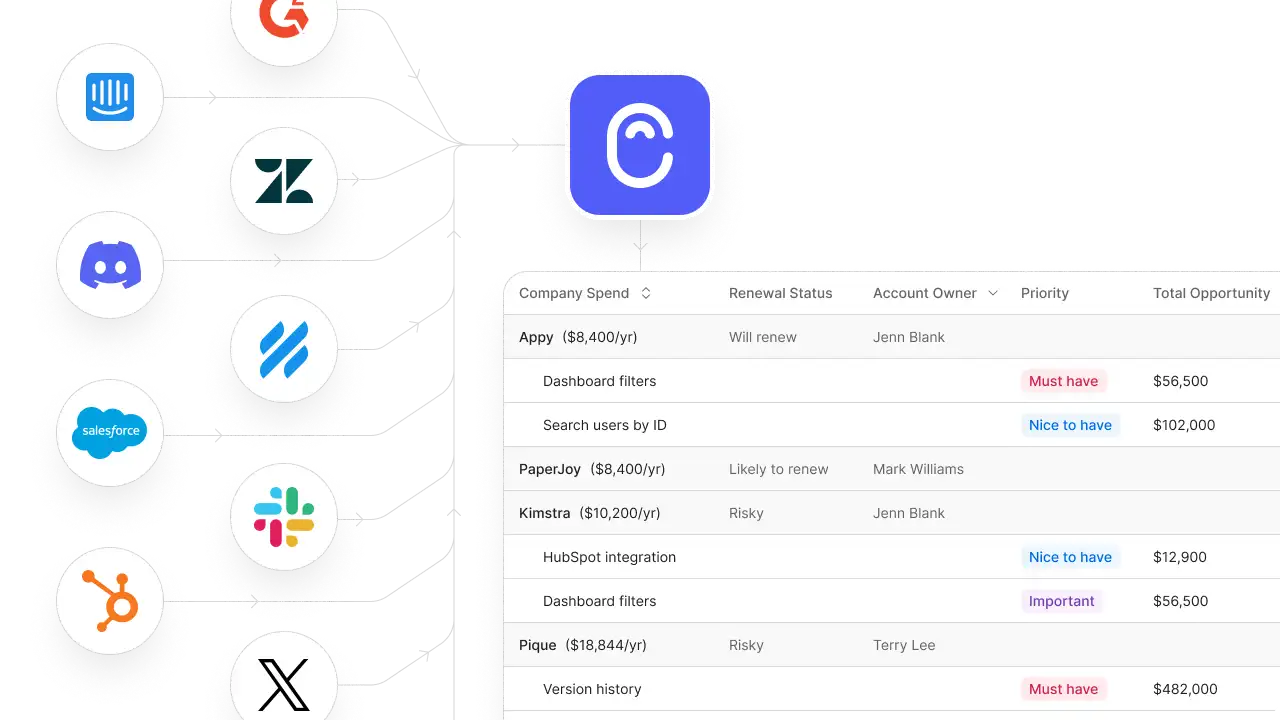
Key Features
- Keeps feedback organized and removes repeated requests.
- Quickly finds the most wanted features.
- Summarizes important points from comments.
- Automatically asks follow-up questions.
- Connects with other tools like Intercom and Zendesk.
Pricing
- Free plan available
- Starter Plan: $79/month
- Growth Plan: $359/month
- Business Plan: Contact for a quote
2. Userpilot
Userpilot helps you ask users for feedback right inside your app. You can easily start surveys like NPS, CSAT, and CES without needing tech help.
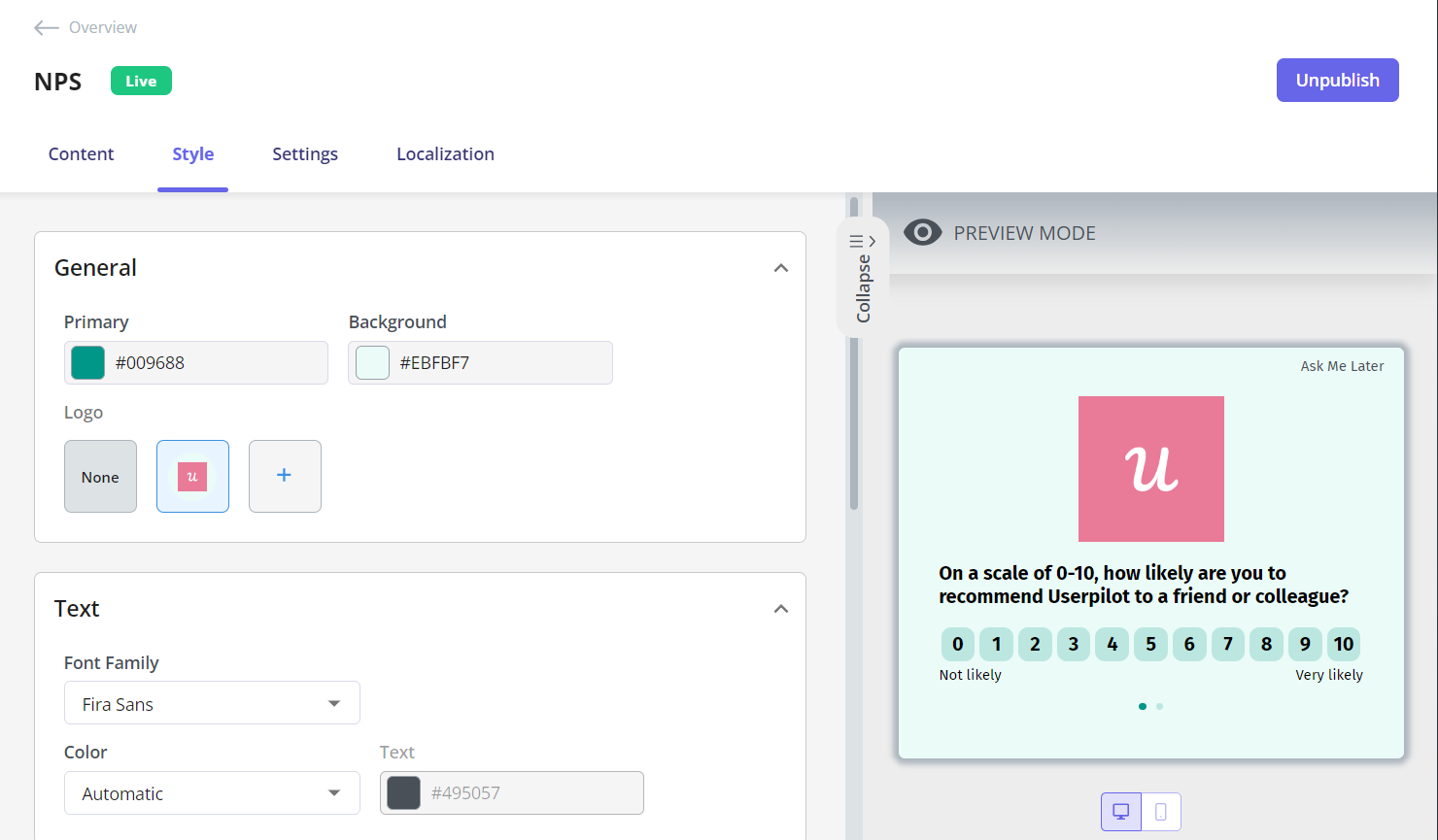
[Source]
With Userpilot, you can check if users are happy and if they like using your features. Asking questions in your app helps you make things better.
Key Features
- Create surveys with different types of questions.
- Over 30 templates for many uses like research and satisfaction.
- Group users by traits to send the right surveys.
- Launch surveys based on actions like completing a checklist.
- Track how many people respond and how long it takes.
Pricing
- Starter Plan: Starts at $249/month
- Growth Plan: Starts at $799/month
- Enterprise Plan: Contact their team for a quote
- Premium Plan: $224/month
3. Chameleon
Chameleon helps you create customized in-app experiences such as tooltips, modals, and walkthroughs to guide users through your product.
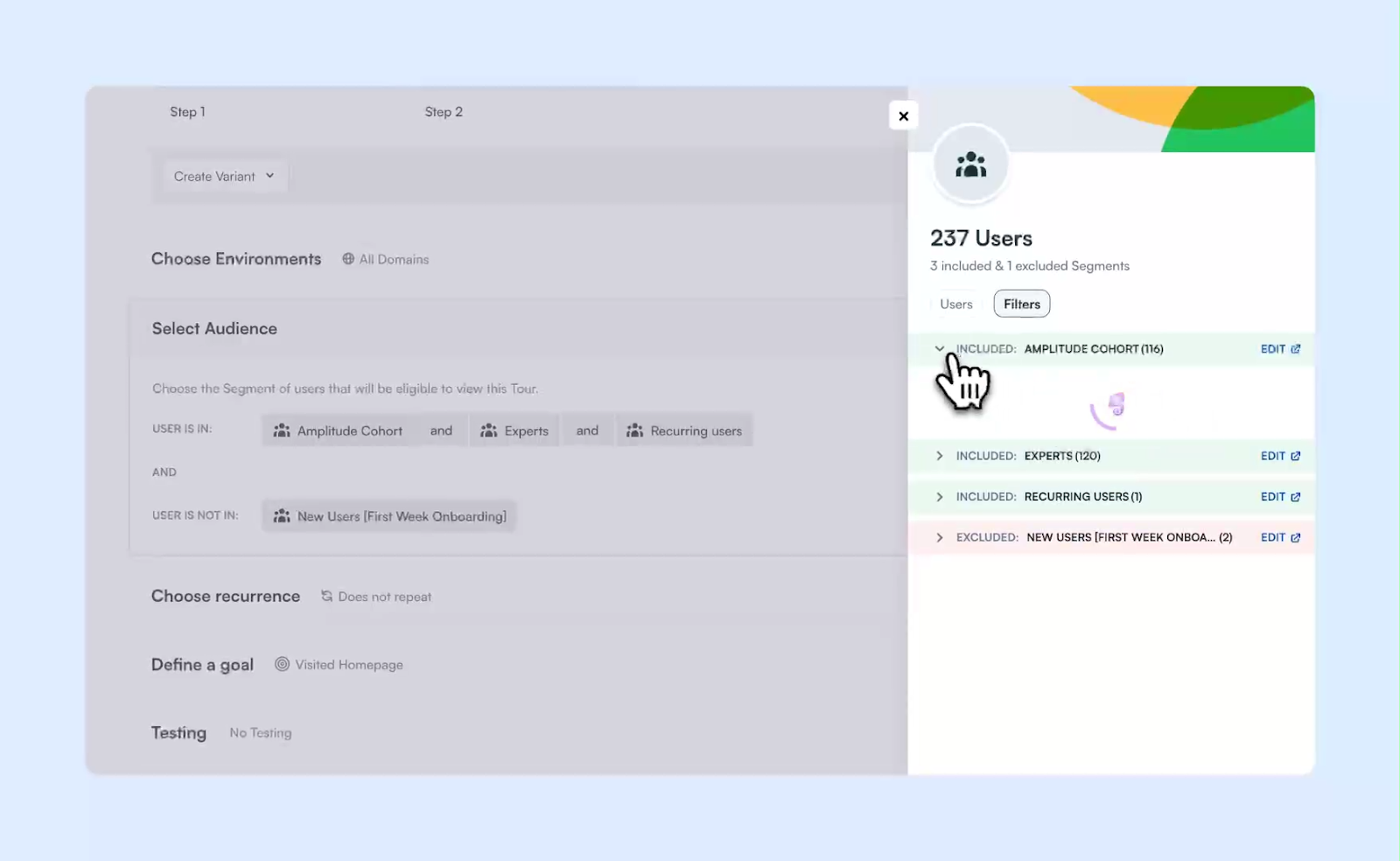
[Source]
It also includes NPS surveys to collect feedback and measure user sentiment, all without needing a developer thanks to its no-code platform.
Key Features:
- Send NPS surveys based on user attributes like role, plan type, or previous responses.
- Trigger follow-up actions such as product tours or helpful messages depending on user survey responses.
- Set surveys to activate based on user actions, such as completing a feature or engaging with a specific part of your product.
- Manage which questions users see to ensure each follow-up addresses their specific challenges or needs.
- Integrate seamlessly with tools like Slack, Mixpanel, Intercom, Typeform, and more for easy data syncing.
Pricing
- HelpBar: Free
- Startup Plan: $279/month
- Growth Plan: $1500/month
- Enterprise: Contact for custom pricing
4. Appcues
Appcues is a product growth tool that boosts user onboarding, adoption, and retention. It allows you to create personalized in-app experiences like onboarding flows and tooltips. It includes NPS surveys to collect user feedback without code using their custom editor.
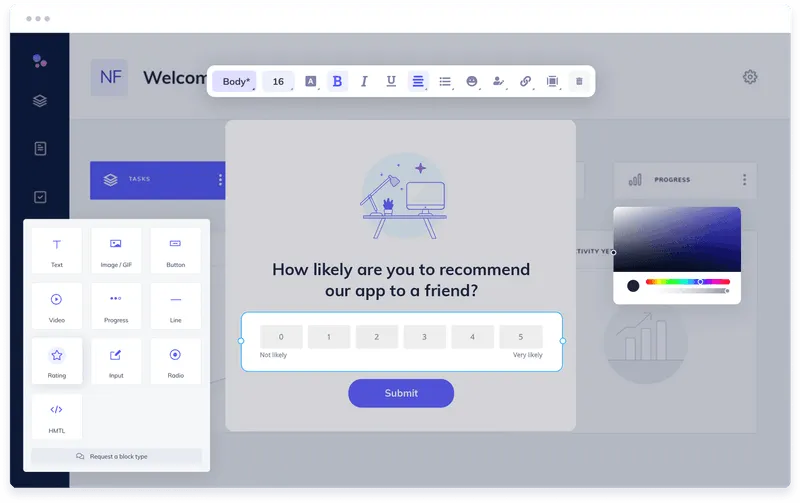
[Source]
The process takes just a few minutes. Once set up, you can control when the survey is visible to users based on persona, lifecycle stage, plan tier, account owner, and more.
Key Features:
- Send targeted NPS surveys based on user behavior or attributes.
- Trigger follow-up actions, like product tours or tips, based on survey responses.
- Customize survey flows and messages to match users’ experiences within the app.
- Integrate with tools like Mixpanel, Drift, Intercom, and more for seamless data syncing.
Pricing:
- Essentials: $249/month
- Growth: $879/month
- Enterprise: Contact for custom pricing
5. FullStory
You’ve got your NPS survey results, and they’re filled with insights on customer satisfaction. But numbers alone don’t give you a clear path forward—you need more context. That’s where FullStory comes in.
As a digital experience intelligence (DXI) platform, FullStory lets you see exactly what users did before giving their feedback. With this insight, you can prioritize changes, improve user experience, and boost both NPS and customer retention.
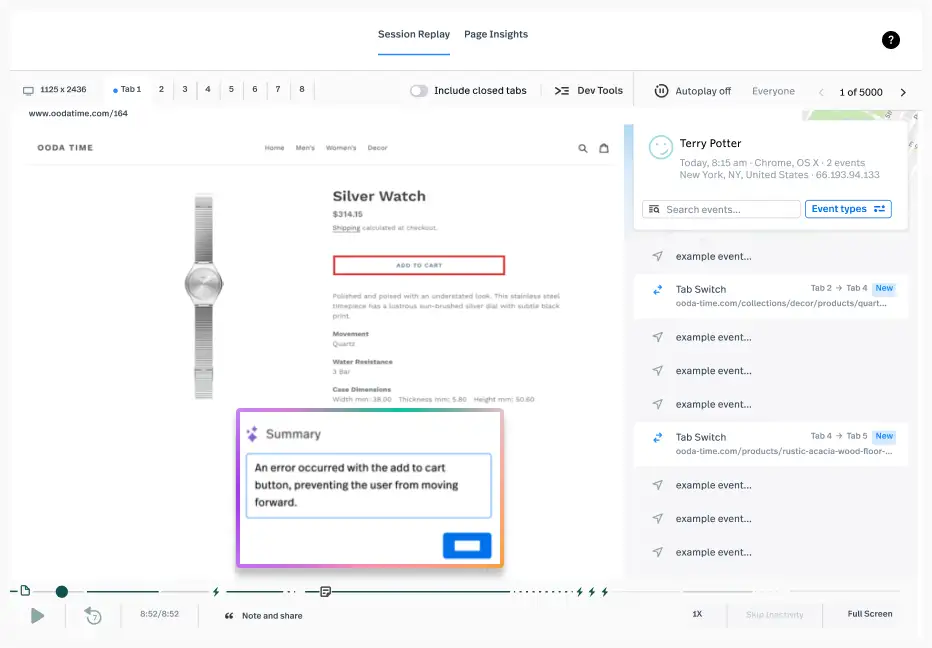
[Source]
Key Features
- Watch real user sessions to see firsthand what users experienced, allowing you to uncover pain points that affect NPS scores.
- Visualize where users are clicking, hesitating, or dropping off, giving clarity on areas needing improvement.
- Analyze specific paths users take to complete goals and identify points of friction that impact customer satisfaction.
- Track custom events tied to user actions and satisfaction, helping to correlate NPS scores with real-time behavior.
Pricing
FullStory’s pricing is based on the scope of your needs and can vary depending on session volumes and features required.
Contact FullStory for a customized quote or explore their free trial to test out the DXI platform before committing.
Start collecting feedback now to improve your NPS
Your best ideas come from your customers. When they share their thoughts—good or bad—they help you get better. Show them you care by making their experience better.
The tools and tips we talked about will help you make your business all about the customer. By paying attention to what they need and giving them great value, your NPS scores will go up.
Are you ready to turn feedback into action? The sooner you start, the faster you’ll see good changes in your NPS and your profits!


